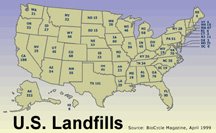Fumes at Stark landfill difficult to stop
The Akron Beacon Journal
PIKE TWP - It might be impossible to halt through chemical injection the reaction behind smoldering underground fires at a Stark County landfill.
Preliminary research conducted by landfill owner Republic Waste Services of Ohio indicates that none of five compounds tested in a laboratory would halt the chemical reactions taking place inside the 258-acre Countywide Recycling & Disposal Facility in Pike Township.
Shaw Environmental Inc., at its New Jersey laboratory, tested three compounds magnesium chloride, sodium silicate and sodium phosphate, all salt-like materials and two commercially available products FirstStrike mine firefighting foam and FlameOut concentrate.
''None of the compounds tested had an effect in controlling or suppressing the aluminum reaction,'' landfill manager Tim Vandersall said in a July 10 letter.
One compound, sodium silicate, actually increased the level of troublesome carbon monoxide gas generated by the reaction, Vandersall said.
Shaw Environmental said the results were unexpected and not easily explained.
The test results are outlined in a series of letters and memos between the company and the Ohio Environmental Protection Agency. The two sides are working on resolving problems at the landfill.
The failed test results would appear to leave two options open: to excavate the 88 acres of the landfill where the fires are smoldering, or to cap that area with 2 feet of clay.
As far as the company is concerned, injection might still be a possibility. ''We're not taking anything off the table at this time,'' spokesman Will Flower said.
EPA ANALYZING PROPOSAL
On March 28, the EPA ordered the company to extinguish underground fires triggered by a chemical reaction and to stop the landfill from producing offensive odors that have plagued residents of southern Stark and northern Tuscarawas counties.
The cause of the fires, the EPA found, was a high-temperature reaction triggered when buried aluminum wastes came in contact with landfill liquids.
The company has paid a $1 million fine for being in violation of its state-issued permits.
On May 29, the company released a 62-page proposal that calls for installing synthetic liners to keep oxygen out of the landfill to extinguish the fires over three to six years.
The EPA has hired a panel of experts to help it analyze the company's proposal. That review continues.
Ohio EPA Director Chris Korleski must determine what steps the agency will order the company to take to deal with the fires and odors.
The company was ordered by the EPA to investigate ways to chemically extinguish the fires and halt the chemical reactions with the aluminum wastes.
It submitted its report on halting the chemical reactions on July 10. The EPA responded with concerns on Aug. 7. The company filed additional data with the agency on Aug. 23.
The EPA noted that the two commercially available products are not designed to extinguish underground fires like those at Countywide.
COMPANY'S CONCERNS
Vandersall, the landfill manager, said that even if a fire-suppressant compound is identified, injecting the liquids through buried solid waste would involve ''significant technical and logistical problems.'' Getting the correct amount and concentration of compounds to suppress the widespread chemical reaction ''would be difficult, if not impossible,'' he warned.
Vandersall said experience with such suppressants makes it unlikely that such a treatment would succeed.
Republic Waste Services and and the EPA are taking firm and differing stands on what's happening inside the landfill.
Countywide continues to argue that the landfill's problems stem from the chemical reaction and not from smoldering fires, as the EPA says.
The company contends that the heat from the chemical reaction is triggering very slow pyrolysis a chemical change in the buried organic waste with no oxygen present, Vandersall said in an Aug. 23 letter.
That can produce charred materials like those found by the EPA, the company says.
At the same time, Shaw Environmental, hired by Republic Waste Services, is suggesting that the high levels of carbon monoxide at Countywide which the EPA blames on fires might be from another source.
Shaw suggests that volatile fatty acids from the landfill's leachate may be causing the high carbon monoxide levels. The landfill's heat could be turning the leachate into carbon monoxide, or the aluminum reaction could be creating the carbon monoxide, the contractor says.
TESTS INDICATE FIRES
The EPA, on the other hand, says levels of carbon monoxide above 1,000 parts per million indicate smoldering fires, and those levels are being found at Countywide.
The EPA maintains that ''a fire is present within the waste mass.''
That conclusion is based partly on new evidence: observations of EPA staffers at Countywide from June 4 to 13, when gas extraction wells were replaced.
Those observations included smoke or steam from drill holes, high carbon monoxide levels, charred landfill solids and melted plastics, a strong burning odor from waste from the drill holes, and high waste temperatures.
The EPA and its experts also questioned the methodology used in the Shaw tests and said the Shaw study ''yields only questionable results,'' EPA staffer Ed Gortner wrote.
Both sides agree that Countywide is running hotter than other landfills from 150 to 230 degrees, rather than the usual 130 degrees.
The EPA remains concerned that the high temperatures could jeopardize the landfill liner and its gas and leachate collection.

